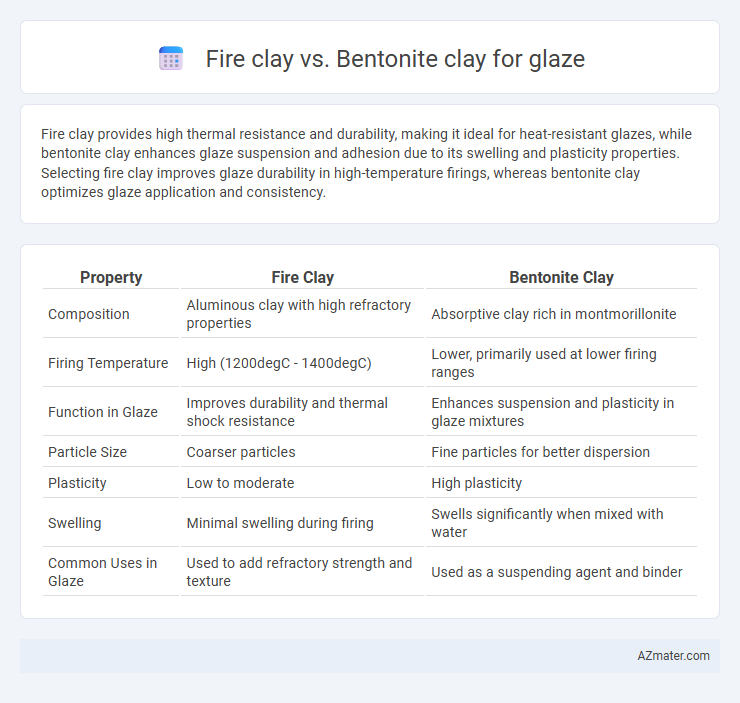Fire clay provides high thermal resistance and durability, making it ideal for heat-resistant glazes, while bentonite clay enhances glaze suspension and adhesion due to its swelling and plasticity properties. Selecting fire clay improves glaze durability in high-temperature firings, whereas bentonite clay optimizes glaze application and consistency.
Table of Comparison
| Property | Fire Clay | Bentonite Clay |
|---|---|---|
| Composition | Aluminous clay with high refractory properties | Absorptive clay rich in montmorillonite |
| Firing Temperature | High (1200degC - 1400degC) | Lower, primarily used at lower firing ranges |
| Function in Glaze | Improves durability and thermal shock resistance | Enhances suspension and plasticity in glaze mixtures |
| Particle Size | Coarser particles | Fine particles for better dispersion |
| Plasticity | Low to moderate | High plasticity |
| Swelling | Minimal swelling during firing | Swells significantly when mixed with water |
| Common Uses in Glaze | Used to add refractory strength and texture | Used as a suspending agent and binder |
Introduction to Fire Clay and Bentonite Clay
Fire clay is a highly refractory clay known for its ability to withstand extremely high temperatures, making it ideal for ceramic glazes that require durability and thermal shock resistance. Bentonite clay, composed primarily of montmorillonite, serves as a powerful binder and suspension agent in glaze formulations, improving plasticity and preventing settling during firing. Choosing between fire clay and bentonite depends on whether heat resistance or glaze suspension quality is the primary requirement.
Chemical Composition Differences
Fire clay primarily consists of kaolinite (Al2Si2O5(OH)4), making it rich in alumina and silica, which provides high refractory properties crucial for glaze durability. Bentonite clay contains a significant amount of montmorillonite, a smectite group mineral, characterized by its swelling capacity and high sodium and calcium ion exchange content affecting glaze viscosity and texture. The chemical composition difference, particularly the higher alumina in fire clay versus the smectite-rich bentonite, influences their melting points, plasticity, and behavior in glaze formulation.
Plasticity and Workability in Glaze Recipes
Fire clay offers moderate plasticity and is valued for its durability and resistance to thermal shock in glaze recipes, enhancing stability during firing. Bentonite clay provides high plasticity and exceptional workability, improving suspension and adherence of glaze materials. Combining fire clay with bentonite balances strength and moldability, optimizing glaze texture and application.
Effects on Glaze Suspension
Fire clay enhances glaze suspension by increasing viscosity and preventing settling due to its coarse particle structure, which promotes better suspension of heavier materials. Bentonite clay, with its fine particles and high swelling capacity, significantly improves glaze suspension by creating a stable colloidal suspension that minimizes sedimentation and ensures uniform glaze application. The combination of fire clay and bentonite can optimize glaze suspension, balancing texture and fluidity for consistent results in ceramic glazing.
Melting Temperatures and Maturity
Fire clay typically matures at higher temperatures ranging from cone 6 to cone 10 (2232degF to 2345degF), making it suitable for stoneware and high-fire glazes that require durability and resistance to melting. Bentonite clay, with a lower melting point around cone 04 to cone 06 (1940degF to 2232degF), acts as a powerful suspension agent and plasticizer but does not significantly contribute to the glaze's maturity or melting characteristics. Combining fire clay for structural maturity and bentonite for improved suspension enhances the glaze formulation's overall performance and workability.
Impact on Glaze Surface Finish
Fire clay enhances glaze surface durability by promoting a smooth, vitrified finish with slight matte texture due to its high alumina content and coarse particle size. Bentonite clay contributes to glaze suspension and adhesion but can cause increased crazing or crazed textures when overused, as its swelling properties affect glaze stability during firing. Optimal glaze formulations balance fire clay's stabilizing effects with bentonite's plasticity to achieve a consistent, defect-free surface finish.
Influence on Glaze Color Response
Fire clay contains iron oxide and other impurities that often result in warmer, earthy tones and can enhance color depth and variation in glaze surfaces. Bentonite clay, being purer and higher in plasticity, influences glaze suspension and texture rather than color, leading to clearer and more consistent color responses. The iron content in fire clay may cause unpredictable color shifts, while bentonite supports stable, true-to-form glaze hues.
Recommendations for Glaze Formulation
Fire clay offers high refractory properties and particle stability, making it ideal for incorporating into high-temperature glaze formulations to improve durability and reduce shrinkage. Bentonite clay, rich in montmorillonite, enhances suspension, plasticity, and adhesion in glaze recipes, ensuring smoother application and better coating uniformity. For optimal glaze performance, combine fire clay to boost thermal resistance with bentonite to increase workability and suspension stability.
Common Applications in Ceramic Glazes
Fire clay is widely used in ceramic glazes to enhance thermal shock resistance and improve durability due to its high alumina content, making it ideal for stoneware and porcelain glazes. Bentonite clay acts as a powerful suspending agent and binder in glaze formulations, ensuring even distribution of materials and preventing settling during application. Both clays contribute to glaze texture and firing characteristics, with fire clay providing a refractory quality and bentonite improving glaze suspension for consistent surface finishes.
Choosing the Right Clay for Your Glaze
Fire clay offers high refractory properties and durability, making it ideal for glazes requiring heat resistance and structural strength. Bentonite clay, rich in montmorillonite, enhances glaze suspension and plasticity, improving application smoothness and adherence. Selecting between fire clay and bentonite depends on balancing thermal stability needs with glaze workability for the desired finish.

Infographic: Fire clay vs Bentonite clay for Glaze
 azmater.com
azmater.com